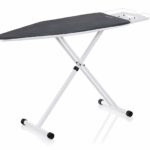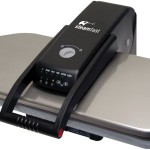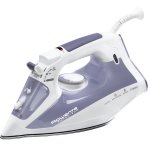This post contains affiliate links which will enable us to earn some commission if you click and buy.
Buying a clothes iron can be a confusing experience. Should you buy an expensive or a cheap iron? Why is it that some irons cost around $10 while others have a price tag of over $100? Should you be spending so much on an iron if all it does is to smooth out wrinkles on your clothes?
This clothes iron buying guide is here to help you answer some of these questions. There are factors to consider when shopping for an iron so that you would end up with one that closely matches your needs. Think about these few issues below before buying:
Which Clothes Iron to Buy?
 Price
Price
Of course, we all have to work within our budget. But in general, the more expensive steam irons would do a better job in getting rid of creases. This is because they tend to have better heat generation and distribution, a slicker soleplate and ample steam output. Combine with a good weight, all these factors will work together to ensure the ironing gets done with less effort and time. When you need more than a few passes to get rid of creases with a cheap iron, you can do the same with a single pass from a high quality steam iron which means less effort is needed for the same task. You will also avoid the common frustration with stubborn wrinkles which can never be completely removed at times with a cheap iron due to insufficient heat and lack of steam output.
So, if you have a heavy ironing load, buying a better steam iron is a good idea in the long run. You might need to pay more now, but it is money well spent since you can cut down on your ironing time and have a more user-friendly experience. Also, if your dressing style includes a wide range of materials including denim and cotton, a cheap iron may not be able to help you smoothen out stubborn wrinkles on these items. Therefore, don’t just go for the cheap steam irons, especially when you are the type that can’t stand even the faintest of creases on your clothes. You will be happier with a better quality iron in this case.
Example of a cheap iron: Panasonic NI-E200T
Example of a high end iron: Rowenta DW6080 Eco Intelligence
Durability
Usually, you would expect a more expensive product to last longer than its cheaper counterpart. But unfortunately, this is not so for steam irons. Going through customer reviews of different brands, you will realize that even the higher end models can have tons of complaints. To make it worse, you can come across two extreme views on the same exact iron, one negatively critical while another would be praising it all the way.
So, if an expensive steam iron may not be durable, then why take the risk and spend so much? After all, if you just go and get a cheaper model, you won’t feel angry and cheated when it is time to get a replacement. While that is true, a cheap iron may not have the features that you need for your ironing load.
That is why we really need to manage our expectations when it comes to owning a clothes iron nowadays. Gone are the days when they seem to last forever. Most steam irons these days will need to be replaced within 3 years. Because water is added into the appliance, it will leave deposits and residues over time and causes the iron to malfunction. The nature of the appliance with its valves, seams and steam holes inevitably leads to leaks and spits after repeated uses over a period of time.
Therefore, before you buy, bear in mind that a steam iron above $100 may not last longer than one that is selling for $50. But as mentioned, while they are fit for use, the difference is in the features that leads to a better user experience for the costlier model. Thus, weigh the durability risk against your needs to arrive at an acceptable price point when shopping for your steam iron.
Example of a quality iron with generally positive reviews: Rowenta DW5080
Ironing Load
A higher priced iron will generally have more features than its cheaper counterpart. For example, a $10 clothes iron will merely be a basic, no-frills model. But pay about $30 more and you can get a steam burst and self-cleaning feature, sufficient for most household needs. For $80, you can have an iron with more steam holes and a high steam output to get rid of the most stubborn wrinkles.
As such, assess your needs first before you go shopping. If you have few items to iron, you don’t really need all the bells and whistles that come with a $100 steam iron. A $30 to $50 model is probably sufficient for your needs. But if you have a large family and you need to press all kinds of fabrics including tough denim, delicate silk and thick curtains, then a top notch iron with various features is a must.
Therefore, work out your ironing load and the types of items you need to press and match those with the features offered by the various models. This will give you an idea which would be the best steam iron for you.
Example of a basic iron: Sunbeam GCSBBV-395-000 Classic
Example of a full-featured iron: Rowenta DW9280
Soleplates
An iron soleplate is the base that glides across the fabric you are pressing. It can be made of and coated with different kinds of materials including stainless steel, aluminum, titanium alloy, ceramic and others. However, there are trade-offs among them with no single material being able to satisfy all customer requirements.
For instance, stainless steel base plate irons tend to be cheaper than ceramic ones and they don’t corrode as easily. Heat distribution is excellent and it glides well at high heat on thicker natural fabrics like cotton to give you sharp creases when needed. It is also durable and tough to better withstand normal wear and tear.
However, stainless steel base soleplates are not perfect when it comes to its nonstick qualities and they tend to lose out to ceramic coated ones. The latter glide smoothly across synthetic fabrics and they are less likely to stick to your garments. But the downside is the coating can peel and you might need to replace the iron then.
Whichever clothes iron that you choose, look for scratch-resistant soleplates that won’t easily get scratched by a button or zipper. You might need to spend a bit more, but if the base plate is easily scratched, the iron won’t glide as well anymore making ironing difficult.
Example of irons with:
- Ceramic soleplate: T Fal FV4495 Ultraglide
- Stainless steel soleplate: Panasonic NI-W810CS Multi-Directional Iron
- Titanium soleplate: Panasonic NI-E650TR
- Platinum soleplate: Rowenta DW9080
- Aluminum soleplate: Black & Decker F67E Classic
More Steam Iron Buying Tips
Apart from the above, below is a summary of other steam iron buying tips to help you out:
- Weight of the iron – Some irons are heavier than others. Consider your own arm strength when deciding on your options and remember that the iron will feel much heavier when filled with water.
- Water tank – A see-through water tank will make it more convenient for you to check the water level. Some also offer a detachable unit to make re-filling more convenient. Next, check the size of the water hole because some can be a little too small that water will flow down the sides while re-filling.
- Type of water – Check the manual to see what type of water can be used with the iron, especially if you are living in places with hard water.
- Controls – Many irons now use digital controls (e.g. Black & Decker D2030) but they may not be suitable for those with poor eyesight. Also, check if any dials and knobs could get in the way when you are gripping the iron.
- Size of the handle – Different people have different hand sizes. What is comfortable for one may not be comfortable for another. Therefore, checking it out in the store before you buy would be best.
- Your clothing – Consider what you regularly need to iron and find one with the right features to match your ironing needs.
Sometimes, the little details can make or break an item. So, pay attention to the details too when shopping so that you will end up with the most suitable steam iron for your home.




Purchasing an iron should be proper for you as if you would but a iron that does not fit for your clothes, then it would give no benefit of using it. You first need to know the type of iron your clothes needed and then you should read some buying guide to make your decision good.